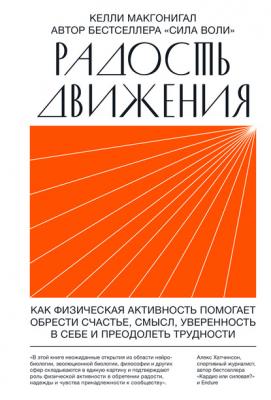ТОП просматриваемых книг сайта:
Радость движения. Как физическая активность помогает обрести счастье, смысл, уверенность в себе и преодолеть трудности. Келли Макгонигал
Читать онлайн.Год выпуска 2019
isbn 978-5-00169-107-5
Автор произведения Келли Макгонигал
Жанр Управление, подбор персонала
Серия МИФ Саморазвитие
Издательство Манн, Иванов и Фербер (МИФ)
7
Dan Sturn. “How Humans Fly.” In Garth Battista, ed., The Runner’s High: Illumination and Ecstasy in Motion (Halcottsville, NY: Breakaway Books, 2014), 178.
8
https://www.reddit.com/r/running/comments/1nbmjc/what_does_the_runners_high_actually_feel_like/.
9
Stephanie Case. “Riding the Runner’s Highs and Braving the Lows.” March 10, 2011; https://ultrarunnergirl.com/2011/03/10/highs_and_lows/.
10
Dennis M. Bramble and Daniel E. Lieberman. “Endurance Running and the Evolution of Homo.” Nature 432, № 7015 (2004): 345–352.
11
Херман Понтцер поделился со мной этой историей в беседе. Вы можете прослушать ее здесь: https://www.storycollider.org/stories/2016/10/22/herman-pontzer-burning-calories.
12
David A. Raichlen et al. “Physical Activity Patterns and Biomarkers of Cardiovascular Disease Risk in Hunter-Gatherers.” American Journal of Human Biology 29, № 2 (2017): DOI: 10.1002/ajhb.22919.
13
Jared M. Tucker, Gregory J. Welk, and Nicholas K. Beyler. “Physical Activity in US Adults: Compliance with the Physical Activity Guidelines for Americans.” American Journal of Preventive Medicine 40, № 4 (2011): 454–461; Vijay R. Varma et al. “Re-evaluating the Effect of Age on Physical Activity over the Lifespan.” Preventive Medicine 101 (2017): 102–108.
14
Raichlen et al. “Physical Activity Patterns and Biomarkers of Cardiovascular Disease Risk in Hunter-Gatherers.”
15
Stephanie A. Hooker and Kevin S. Masters. “Purpose in Life Is Associated with Physical Activity Measured by Accelerometer.” Journal of Health Psychology 21, № 6 (2016): 962–971.
16
Neal Lathia et al. “Happier People Live More Active Lives: Using Smartphones to Link Happiness and Physical Activity.” PLoS One 12, № 1 (2017): e0160589.
17
Jaclyn P. Maher et al. “Daily Satisfaction with Life Is Regulated by Both Physical Activity and Sedentary Behavior.” Journal of Sport and Exercise Psychology 36, № 2 (2014): 166–178.
18
Romano Endrighi, Andrew Steptoe, and Mark Hamer. “The Effect of Experimentally Induced Sedentariness on Mood and Psychobiological Responses to Mental Stress.” The British Journal of Psychiatry: The Journal of Mental Science 208, № 3 (2016): 245–251.
19
Meghan K. Edwards and Paul D. Loprinzi. “Experimentally Increasing Sedentary Behavior Results in Increased Anxiety in an Active Young Adult Population.” Journal of Affective Disorders 204 (2016): 166–173; Meghan K. Edwards and Paul D. Loprinzi. “Effects of a Sedentary Behavior – Inducing Randomized Controlled Intervention on Depression and Mood Profile in Active Young Adults.” Mayo Clinic Proceedings 91, № 8 (2016): 984–998; Meghan K. Edwards and Paul D. Loprinzi. “Experimentally Increasing Sedentary Behavior Results in Decreased Life Satisfaction.” Health Promotion Perspectives 7, № 2 (2017): 88–94.
20
Tim Althoff et al. “Large-Scale Physical Activity Data Reveal Worldwide Activity Inequality.” Nature 547, № 7663 (2017): 336–339.
21
См.: Bramble and Lieberman. “Endurance Running and the Evolution of Homo”; Herman Pontzer. “Economy and Endurance in Human Evolution.” Current Biology 27, № 12 (2017): R613–621; Jay Schulkin, “Evolutionary Basis of Human Running and Its Impact on Neural Function.” Frontiers in Systems Neuroscience 10 (2016): 59.
22
Herman Pontzer. “The Exercise Paradox.” Scientific American, February 2017. Цитата на с. 27.
23
Tiina Saanijoki et al. “Opioid Release After High-Intensity Interval Training in Healthy Human Subjects.” Neuropsychopharmacology 43, № 2 (2018): 246–254; Henning Boecker et al., “The Runner’s High: Opioidergic Mechanisms in the Human Brain.” Cerebral Cortex 18, № 11 (2008): 2523–2531.
24
Patrick M. Whitehead. “The Runner’s High Revisited: A Phenomenological Analysis.” Journal of Phenomenological Psychology 47, № 2 (2016): 183–198.
25
David A. Raichlen et al., “Exercise-Induced Endocannabinoid Signaling Is Modulated by Intensity.” European Journal of Applied Physiology 113, № 4 (2013): 869–875.
26
David A. Raichlen et al. “Wired to Run: Exercise-Induced Endocannabinoid Signaling in Humans and Cursorial Mammals with Implications for the ‘Runner’s High.’” Journal of Experimental Biology 215, № 8 (2012): 1331–1336.
27
Angelique G. Brellenthin et al. “Endocannabinoid and Mood Responses to Exercise in Adults with Varying Activity Levels.” Translational Journal of the American College of Sports Medicine 2, № 21 (2017): 138–145; E. Heyman et al. “Intense Exercise Increases Circulating Endocannabinoid and BDNF Levels in Humans – Possible Implications for Reward and Depression.” Psychoneuroendocrinology 37, № 6 (2012): 844–851; P. B. Sparling et al. “Exercise Activates the Endocannabinoid System.” NeuroReport 14, № 17 (2003): 2209–2211; M. Feuerecker et al. “Effects of Exercise Stress on the Endocannabinoid System in Humans Under Field Conditions.” European Journal of Applied Physiology 112, № 7 (2012): 2777–2781.
28
Цитируется по: Elizabeth Cassidy, Sandra Naylor, and Frances Reynolds. “The Meanings of Physiotherapy and Exercise for People Living with Progressive Cerebellar Ataxia: An Interpretative Phenomenological Analysis.” Disability and Rehabilitation 40, № 8 (2018): 894–904.
29
Роман Стивена Кинга и одноименный фильм ужасов; в центре сюжета – собака по имени Куджо, заболевшая бешенством. Прим. пер.
30
David Fleming. “Slow and Steady Wins the Planet.” ESPN, February 11, 2011; http://www.espn.com/espn/news/story?id=6110087.
31
Adharanand

